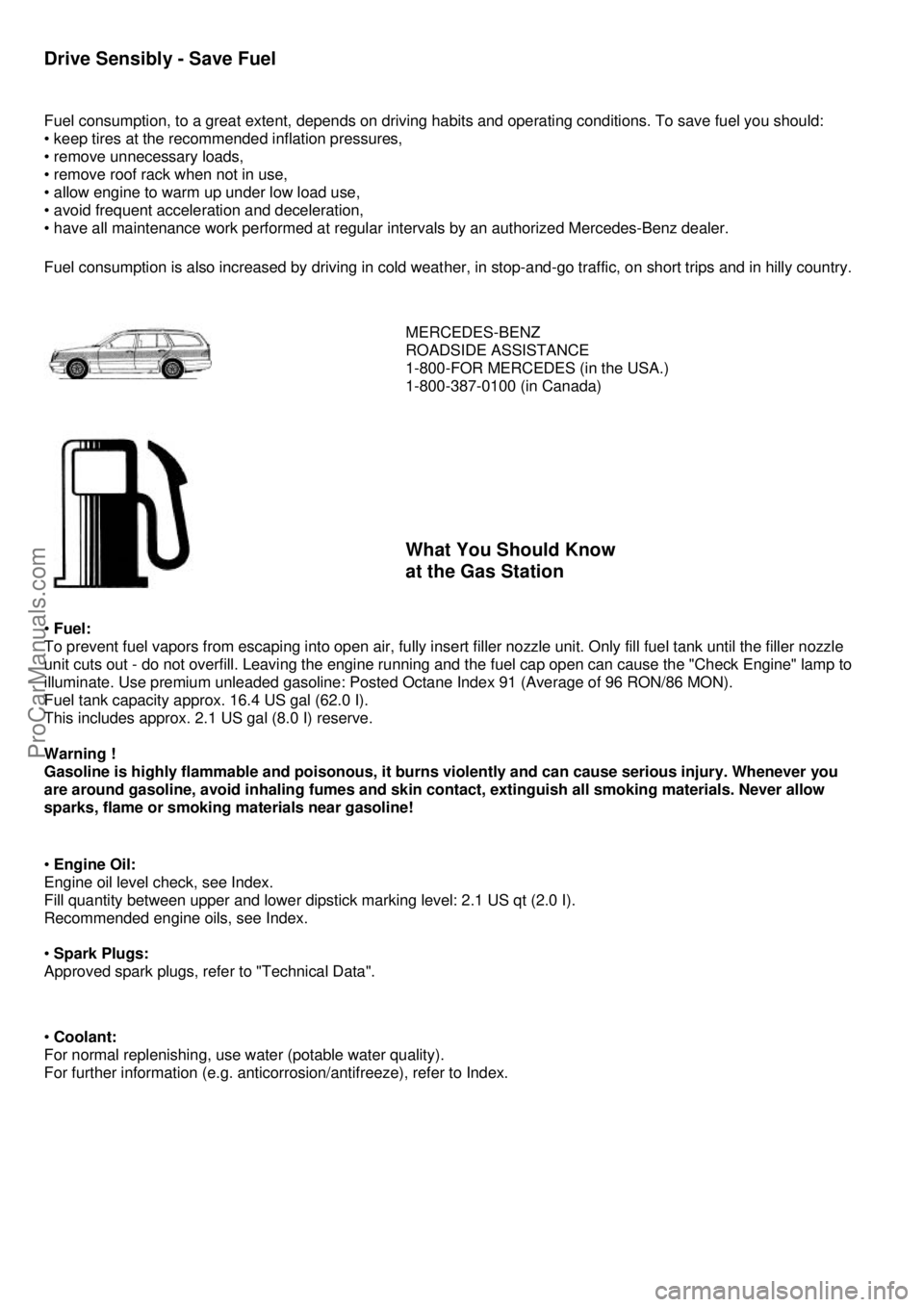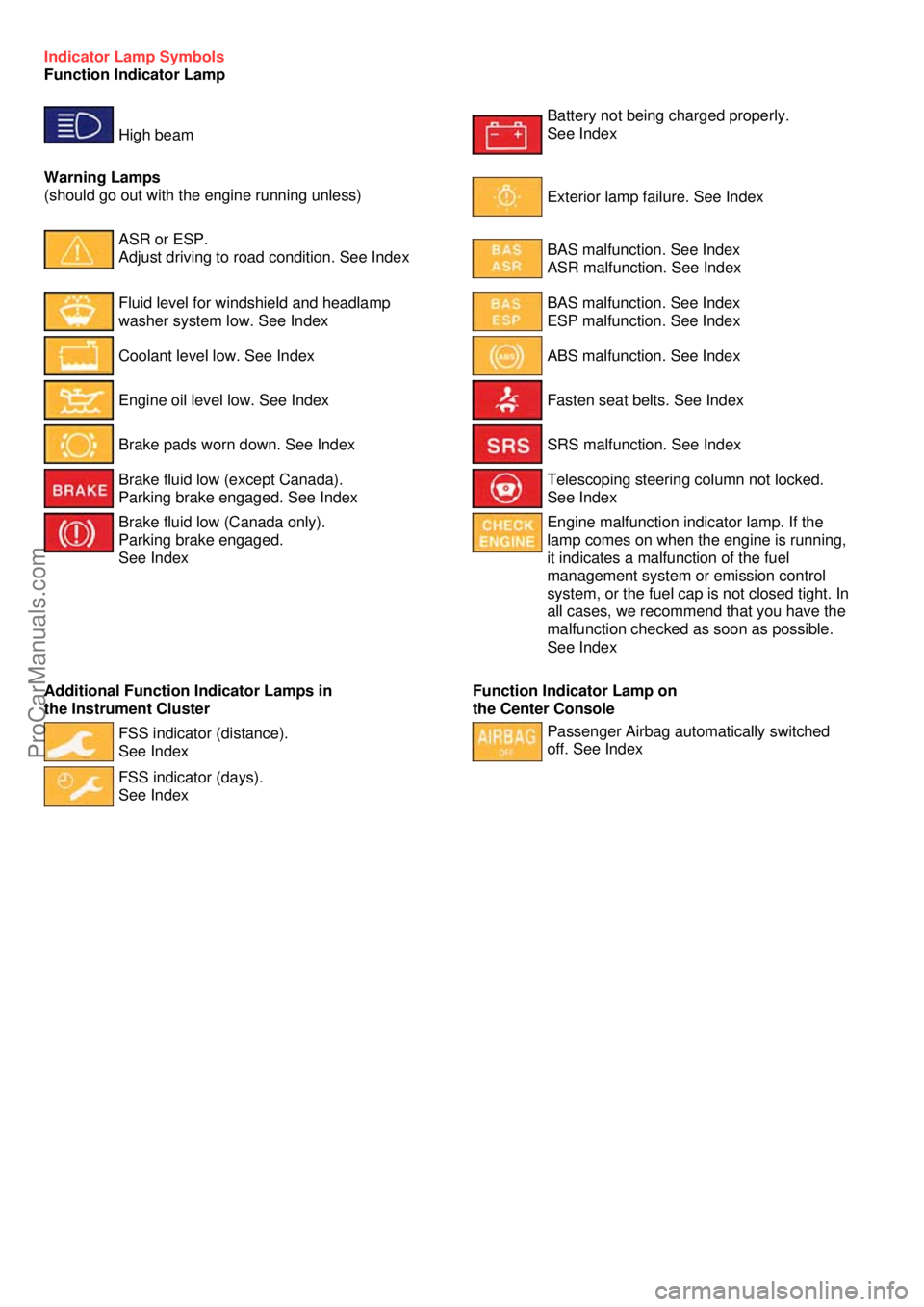check engine MERCEDES-BENZ C-CLASS 1999 Owners Manual
[x] Cancel search | Manufacturer: MERCEDES-BENZ, Model Year: 1999, Model line: C-CLASS, Model: MERCEDES-BENZ C-CLASS 1999Pages: 122, PDF Size: 1.66 MB
Page 1 of 122

Drive Sensibly - Save Fuel
Fuel consumption, to a great extent, depends on driving habits and operating conditions. To save fuel you should:
• keep tires at the recommended inflation pressures,
• remove unnecessary loads,
• remove roof rack when not in use,
• allow engine to warm up under low load use,
• avoid frequent acceleration and deceleration,
• have all maintenance work performed at regular intervals by an authorized Mercedes-Benz dealer.
Fuel consumption is also increased by driving in cold weat her, in stop-and-go traffic, on short trips and in hilly country.
MERCEDES-BENZ
ROADSIDE ASSISTANCE
1-800-FOR MERCEDES (in the USA.)
1-800-387-0100 (in Canada)
What You Should Know
at the Gas Station
• Fuel:
To prevent fuel vapors from escaping into open air, fully inse rt filler nozzle unit. Only fill fuel tank until the filler nozzl e
unit cuts out - do not overfill. Leaving the engine running and t he fuel cap open can cause the "Check Engine" lamp to
illuminate. Use premium unleaded gasoline: Posted Octane Index 91 (Average of 96 RON/86 MON).
Fuel tank capacity approx. 16.4 US gal (62.0 I).
This includes approx. 2.1 US gal (8.0 I) reserve.
Warning !
Gasoline is highly flammable and poisonous, it burns violently and can cause serious injury. Whenever you
are around gasoline, avoid inhaling fumes and skin cont act, extinguish all smoking materials. Never allow
sparks, flame or smoking materials near gasoline!
• Engine Oil:
Engine oil level check, see Index.
Fill quantity between upper and lower dipstick marking level: 2.1 US qt (2.0 I).
Recommended engine oils, see Index.
• Spark Plugs:
Approved spark plugs, refer to "Technical Data".
• Coolant:
For normal replenishing, use water (potable water quality).
For further information (e.g. anticor rosion/antifreeze), refer to Index.
ProCarManuals.com
Page 5 of 122

Indicator Lamp Symbols
Function Indicator Lamp
High beam
Battery not being charged properly.
See Index
Warning Lamps
(should go out with the engine running unless)
Exterior lamp failure. See Index
ASR or ESP.
Adjust driving to road condition. See Index
BAS malfunction. See Index
ASR malfunction. See Index
Fluid level for windshield and headlamp
washer system low. See Index
BAS malfunction. See Index
ESP malfunction. See Index
Coolant level low. See Index
ABS malfunction. See Index
Engine oil level low. See Index Fasten seat belts. See Index
Brake pads worn down. See Index SRS malfunction. See Index
Brake fluid low (except Canada).
Parking brake engaged. See Index
Telescoping steering column not locked.
See Index
Brake fluid low (Canada only).
Parking brake engaged.
See Index
Engine malfunction indicator lamp. If the
lamp comes on when the engine is running,
it indicates a malfunction of the fuel
management system or emission control
system, or the fuel cap is not closed tight. In
all cases, we recommend that you have the
malfunction checked as soon as possible.
See Index
Additional Function Indicator Lamps in
the Instrument Cluster
Function Indicator Lamp on
the Center Console
FSS indicator (distance).
See Index
Passenger Airbag automatically switched
off. See Index
FSS indicator (days).
See Index
ProCarManuals.com
Page 7 of 122

Starting and Turning Off the Engine
Before Starting
Ensure that parking brake is engaged and that selector lever is in position "P" or "N".
Turn electronic key in steering lock to position 2. The charge indicator lamp should come on.
Starting (Model C 230)
Do not depress accelerator. Turn electronic key in steering lock clockwise to the stop.
Release electronic key only when the engine is firing regularly.
Starting
(Models C 280, C 43 AMG)
Do not depress accelerator. Briefly turn electronic ke y in steering lock clockwise to the stop and release.
The starter will engage until the engine is running. If engi ne will not run, and the starting procedure stops,
turn electronic key completely to the left and repeat star ting the engine. After several unsuccessful attempts,
have the system checked at the near est authorized Mercedes-Benz dealer.
Important!
Due to the installed starter non- repeat feature, the electronic key must be turned completely to the left before
attempting to start the engine again. The battery charge indicator lamp should go out as soon as the engine
has started. In areas where temperat ures frequently drop below -4°F (-20°C) we recommend that an engine block
heater be installed. Your authorized Mercedes -Benz dealer will advise you on this subject.
Turning Off
Turn the electronic key in the steering lock to position 0 to stop the engine.
The electronic key can only be removed with your foot off the brake pedal and the selector lever in position "P".
ProCarManuals.com
Page 8 of 122

Driving Instructions
Warning !
If you feel a sudden significant vibration or ride disturbance, or you suspect that possible damage
to your vehicle has occurred, you should turn on the hazard flashers, carefully slow down, and drive with
caution to an area which is a safe distance from the roadway.
Inspect the tires and under the vehicle for possible dama ge. If the vehicle or tires appear unsafe, have
it towed to the nearest Mercedes-Benz or tire dealer for repairs.
Power Assistance
Warning !
When the engine is not running, the brake and steering systems are without power assistance.
Under these circumstances, a much greater effo rt is necessary to stop or steer the vehicle.
Brakes
Warning !
After driving in heavy rain for some time without applying the brakes or through water deep enough to
wet brake components, the first braking action may be somewhat reduced and increased pedal
pressure may be necessary. Be sure to maintain a safe distance from vehicles in front.
Resting your foot on the brake pedal will cause excessive and premature wear of the brake pads.
It can also result in the brakes overheating th ereby significantly reducing their effectiveness.
It may not be possible to stop the car in sufficient time to avoid an accident.
The condition of the parking brake system is checked eac h time the car is in the shop for the required service.
If the parking brake is released and the brake warning lamp in the instrument cluster stays on, the brake fluid level in
the reservoir is too low. Brake pad wear or a leak in the system may be the reason for low brake fluid in the reservoir.
Have the brake system inspected at an aut horized Mercedes-Benz dealer immediately.
All checks and maintenance work on the brake system s hould be carried out by an authorized Mercedes-Benz dealer.
Install only brake pads and brake fluid recommended by Mercedes-Benz.
Warning !
If other than recommended brake pads are installed, or other than recommended brake fluid is used, the
braking properties of the vehicle can be degraded to an extent that safe braking is substantially impaired.
This could result in an accident.
Caution !
When driving down long and steep grades, relieve the load on the brakes by shifting into a lower gear. This helps prevent
overheating of the brakes and reduces brak e pad wear. After hard braking, it is advisable to drive on for some time, rather
than immediately parking, so the air stream will cool down the brakes faster.
ProCarManuals.com
Page 65 of 122

Program Mode Selector Switch
The transmission is provided with a selector switch for Standard "S" and Winter/Wet
(snow and ice) "W" program modes.
Important !
Always be certain of the program mode se lected since the vehicle driving characteristics change with the selection of
the program mode.
S Standard mode
Press switch on symbol "S". Use this mode for a ll regular driving. The vehicle starts out in 1st gear.
W Winter/Wet (snow and ice) mode Press switch on symbol "W". The vehicle starts out in 2nd gear, except
lever in 1st gear, or with accelerator pedal in kick-dow n position. The "W" mode helps to imp upshifts occur at lower
vehicle and engine speeds than in the "S" program mode.
Caution !
Never change the program mode? when the selector lever is out of position "P". It could result in a change of driving
characteristics for which you may not be prepared.
Emergency Operation (Limp Home Mode)
If vehicle acceleration worsens, or the transmission no longe r shifts, the transmission is most likely operating in Limp
Home Mode which engages when there is a malfunction at the transmission. This condition may be accompanied by
the "CHECK ENGINE" malfunction indicator lamp in the instrument cluster coming on.
In this mode only the 2nd gear or reverse gear can be activated.
To engage 2nd gear or reverse:
1 . Stop the vehicle.
2 . Move selector lever to position "P".
3 . Turn off the engine.
4 . Wait 10 seconds.
5 . Restart the engine.
6 . Move selector lever to position "D" (for 2nd gear), or move selector lever to position "R" (for reverse gear).
Have the transmission checked at your authorized Mercedes-Benz dealer as soon as possible.
ProCarManuals.com
Page 66 of 122

Cruise Control
Cruise Control
Any given speed above approximately 22 mph (35 km/h) can be maintained with the cruise control by operating the
lever.
1. Accelerate and set:
Lift lever briefly to set speed. Hold lever up to accelerate.
2. Decelerate and set:
Depress lever briefly to set sp eed. Hold lever down to decelerate.
Normally the vehicle is accelerated to the desired speed with the accelerator. Speed is set by briefly pushing
the lever to position 1 or 2. The accelerator can be released. The speed can be increased (e.g. for passing)
by using the accelerator. As soon as the accelerator is released, the previously set speed will be resumed
automatically. If a set speed is to be increased or decreased slightly, e.g. to adapt to the traffic flow, hold lever in
position 1 or 2 until the desired speed is reached, or br iefly tip the control lever in the appropriate direction for
increases or decreases in 0.6 mph (1 km/h) increment s. When the lever is released, the newly set speed remains.
3. Canceling
To cancel the cruise control, briefly push lever to position 3.
When you step on the brake or the vehicle speed drops below approx. 22 rnph (35 km/h), for example when driving
upgrade, the cruise control will be canceled. If the cruise control cancels by itself and remains inoperative until the
engine is restarted, have the syst em checked at your authorized Mercedes-Benz dealer as soon as possible.
4. Resume
If the lever is briefly pushed to position 4 when drivi ng at a speed exceeding approx. 22 mph (35 km/h), the vehicle
resumes the speed which was set prior to the cancella tion of the cruise control. The last memorized speed is
canceled when the key in the steering lock is turned to position 1 or 0.
Note:
If the engine does not brake the vehicle sufficiently while dr iving on a downgrade, the speed you set on the cruise
control may be exceeded and you may have to step on the brake pedal to slow down.
As soon as the grade eases, the cruise controlled speed w ill again be maintained as long as the brakes were not
previously applied, or the lever may be used to resume the previously set speed if the brakes were applied.
Caution !
Moving gear selector lever to position "N" switches the cruise control off.
Warning !
Only use the cruise control if the traffic and weather conditions make it advisable to travel at a steady speed.
• The use of cruise control can be dangerous on winding roads or in heavy traffic because conditions do not
allow safe driving at a steady speed.
• The use of cruise control can be dangerous on slippery roads. Rapid changes in tire adhesion can result
in wheel spin and loss of control.
The "Resume" function should only be operated if the driv er is fully aware of the previously set speed and
wishes to resume this particular preset speed.
ProCarManuals.com
Page 67 of 122

Charge Indicator Lamp
Should the charge indicator lamp fail to come on prior to starting when the electronic key is in steering lock position 2
or should it fail to go out after starting or during operati on, this indicates a fault which must be repaired at an
authorized Mercedes-Benz dealer immediately.
If the charge indicator lamp comes on while the engine is ru nning, this may indicate that the poly-V-belt has broken.
Should this condition occur, the poly-V-bel t must be replaced before continuing to operate the vehicle. Otherwise, the
engine will overheat due to an inoperative water pump which may result in damage to the engine.
Do not continue to drive the vehicle with the charge indicator lamp illuminated. Doing so could result in serious engine
damage that is not covered by the Mercedes-Benz Limited Warranty.
Low Engine Oil Level Warning Lamp
With the electronic key in steering lock position 2, the o il level warning lamp comes on. It should go out immediately
when the engine is running.
If the warning lamp does not go out after starting the engi ne, or comes on with the engine running and at operating
temperature, the engine oil level has dropped to approximately the minimum mark on the dipstick.
When this occurs, the warning lamp will first come on intermittently and then stay on if the oil level drops further.
If no oil leaks are noted, continue to drive to the nearest service station where the engine oil should be topped to the
"full" mark on the dipstick with an approved oil.
The low engine oil level warning light should not be ignored. Extended driving with the light illuminated could result in
serious engine damage that is not covered by the Mercedes -Benz Limited Warranty. In addition to the warning lamp,
the engine oil level should be periodically checked with the di pstick (or via the odometer display - Model 280 only), for
example during a fuel stop, or before a long trip (see Index)
ProCarManuals.com
Page 68 of 122

Engine Oil Consumption
Engine oil consumption checks should only be made after the break-in period. During the break-in period, higher oil
consumption may be noticed and is normal. Frequent driving at high engine speeds results in increased consumption.
Fuel Reserve and Fuel Cap Placement Warning Lamp
With the electronic key in steering lock position 2, the fuel reserve warning lamp comes on. It should go out
immediately when the engine is running.
If the warning lamp does not go out after starting the engine, or if it comes on while driving, it indicates that the fuel
level is down to the reserve quantity of approximately 2.1 gal (8 liters).
The warning lamp blinks when the fuel c ap is not closed, or a fuel system leak has been detected. Retighten cap and
see if lamp goes out.
If the warning lamp continues to blink after closing the fuel cap correctly, hav e the fuel system checked at your
authorized Mercedes-Benz dealer as soon as possible.
Leaving the engine running and the fuel cap open can cause the "Check Engine" lamp to illuminate).
Tachometer
Red marking on tachometer: Excessive engine speed. Avoid th is engine speed, as it may result in serious engine
damage that is not covered by the Mercedes-Benz Limited Warranty. For engine protection, the fuel supply is
interrupted if the engine is operated within the red marking.
Seat Belt Warning Lamp
With the electronic key in steering lock position 2, the warning lamp comes on, and a warning sounds for a short time
if the drivers seat belt is not fastened. After starting the engine, the warning lamp blinks for a brief period to remind
the driver and passengers to fasten seat belts.
ProCarManuals.com
Page 70 of 122

Low Engine Coolant Level Warning Lamp
With the electronic key in steering lock position 2, the warning lamp comes on.
It should go out when the engine is running. If the warning lamp does not go out after starting the
engine, or if it comes on while driving, then the coolant level has dropped below the required level. If
no leaks are noticeable and the engine temperature does not increase, continue to drive to the
nearest service station and have coolant added to the coolant system (see Index).
The low engine coolant level warning light should not be ignored. Extended driving with the light
illuminated may cause serious engine damage not co vered by the Mercedes-Benz Limited Warranty.
In cases of major or frequent minor coolant lo ss, have the cooling system checked at your
authorized Mercedes-Benz dealer as soon as possible.
Note:
Do not drive without coolant in the cooling sy stem. The engine will overheat causing major engine
damage. Monitor the coolant temperature gauge while driving.
Warning !
Do not spill antifreeze on hot engine parts. Antifreeze contains ethylene glycol which may
burn if it comes into contact with hot engine parts. You can be seriously burned.
Low Windshield and Headlamp Washer System Fluid Level Warning Lamp
With the electronic key in steering lock position 2, the warning lamp comes on. It should go out when
the engine is running. If the warning lamp does not go out after starting the engine, or if it comes on
while driving, the level of the reservoir has droppe d to approx.1/4 of the total volume. The reservoir
should be refilled with MB Windshield Washer Concentrate "S" and water (or commercially available
premixed windshield washer solvent/antifreeze, depending on ambient temperature - see Index) at
the next opportunity. The reservoir for the windshie ld and headlamp washer systems is located in
the engine compartment.
ProCarManuals.com
Page 71 of 122

Exterior Lamp Failure Indicator Lamp
With the electronic key in steering lock position 2, an indicator lamp comes on. It should go out when the engine is
running. If the warning lamp does not go out after starting the engine, or if it comes on while driving, this lamp
indicates a failure in the parking lamp, taillamp, stop lamp, or low beam headlamp. If an exterior lamp fails, the
indicator lamp will come on only when that lamp is switched on. If a brake lamp fails, the lamp failure indicator will
come on when applying the brake and st ay on until the engine is turned off.
Note:
If additional lighting equipment is installed (e.g. auxiliary headl amps etc.) be certain to connect into the fuse before
the failure indicator monitoring unit in order to avoid damaging the system.
Brake Pad Wear Indicator Lamp
With the electronic key in steering lock position 2, the brake pad wear indicator lamp comes on for approximately 30
seconds. It goes out when the engine is running.
If the indicator lamp lights up during braking, this indica tes that the brake pads are worn down. Have the brake
system checked at your authorized Mercedes- Benz dealer as soon as possible.
Brake Warning Lamp
With the electronic key in steering lock position 2, the brake warning lamp will come on. It should go out when the
engine is running. The brake warning lamp will come on:
• when there is insufficient brake fluid in the rese rvoir (engine running and parking brake released), or
• when the parking brake is set (engine running).
Warning !
Driving with the brake warning lamp on can result in an accident. Have your brake system checked
immediately if the brake warning lamp stays on. Don't add brake fluid before checking the brake system.
Overfilling the brake fluid reservoir can result in spilling brake fluid on hot engine parts and the brake fluid
catching fire. You can be seriously burned.
If you find that the minimum mark on the brake fluid reserv oir is reached, have the brake system checked for brake
pad thickness and leaks. To test the brake warning lamp, turn electronic key in steering lock to position 2. The brake
warning lamp comes on, and should go out when the engine is running.
ProCarManuals.com